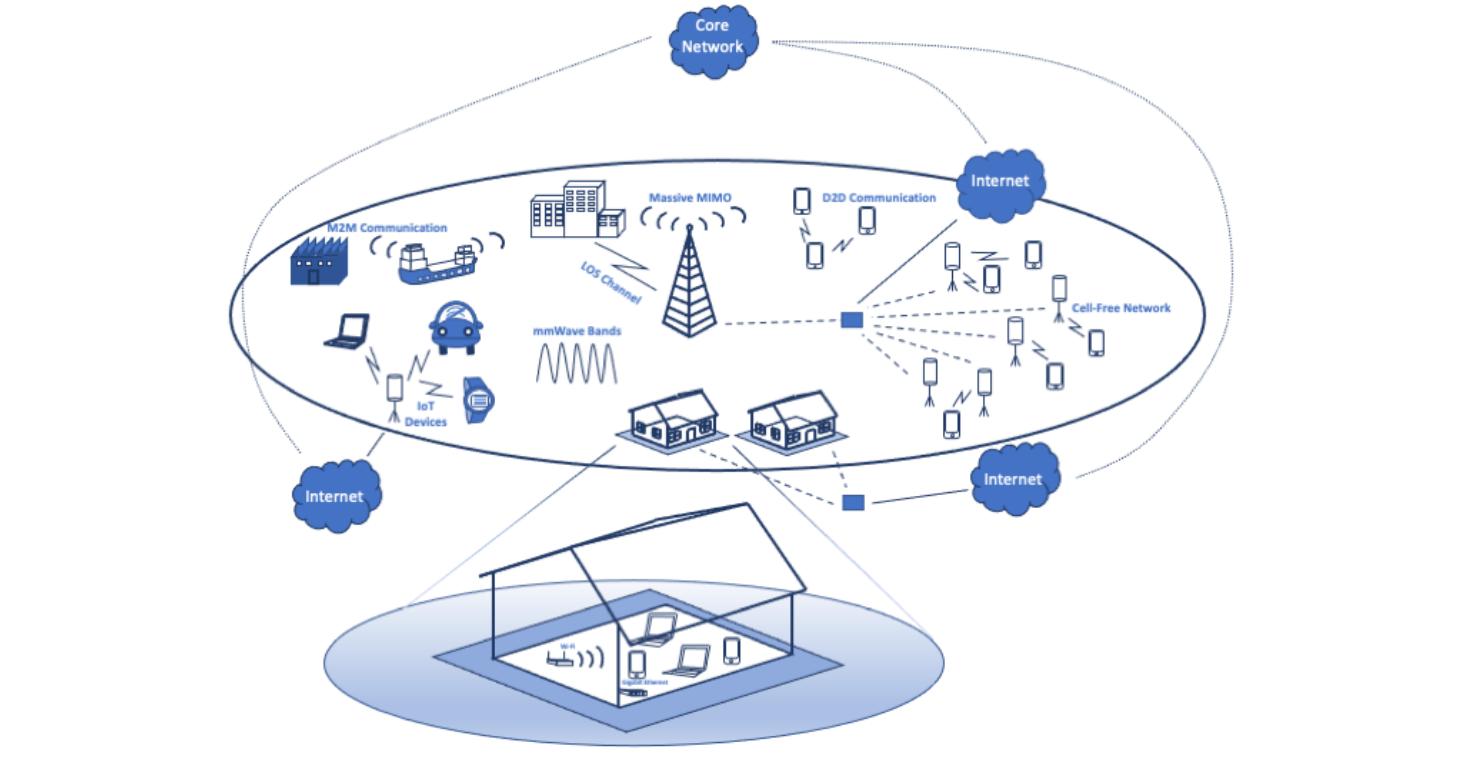Beyond-Fifth-Generation (B5G) Wireless Communication Systems
While the fifth generation (5G) of wireless communication systems are being commercialized and deployed in practice, academia is already working on technologies for next generation wireless systems. One of the main requirements for such future communication systems is to deliver even higher data rates, in the order of Gbits/s, while promoting low latency, green, and sustainable wireless communication. Therefore, the sixth generation (6G) is expected to integrate and combine emerging communication technologies, such as massive multiuser MIMO, millimeter-wave (mmWave) and terahertz (THz) communication, cell-free communication, reconfigurable intelligent surfaces, ultra low-latency short-packet transmission, and artificial intelligence (AI)-assisted baseband processing.
The IIP Group focuses on theory, algorithm development, architecture design, and hardware implementations of novel technologies for such beyond fifth-generation (5G) wireless communication systems. By combining communication theory with machine learning, supervised and self-supervised deep learning, (non-)convex optimization, digital signal processing, and integrated circuit design, we develop efficient solutions that satisfy the requirements of future wireless systems in a hardware-efficient manner.
Theory and Algorithms

The IIP Group is developing new algortihms and theory for millimeter-wave (mmWave) and terahertz (THz) multi-antenna wireless communication systems. Our methods exploit the specific propagation properties of electromagnetic waves at such high frequencies (e.g., high attenuation, directionality, etc.). Our algorithms are designed to achieve best-in-class performance (in terms of achievable rates or error-rate) while being efficient and hardware friendly. In addition, our algorithms are able to cope with real-world hardware impairments (e.g., phase noise, amplifier nonlinearities, quantization artifacts, etc.) and robust to system variations. We furthermore develop a solid theoretical underpinning of our algorithms.
The IIP group is also developing novel algorithms and theory for cell-free massive multiuser MIMO wireless systems. In this area, we develop optimization-based algorithms that are scalable to a large number of distributed access points while achieving best-in-class performance and minimizing interconnect and chip input/output bandwidth. In addition, we are addressing emerging challenges in terms of power control, data-detection complexity, multiuser precoding, methods to minimize backhaul capacity constraints, and user selection and grouping strategies. The primary goal is to develop new decentralized solutions that maximize energy and spectral efficiency, while being scalable, computationally efficient, and ready for the next generation of wireless networks.
The IIP group is also invested in improving energy efficiency, which can be accomplished by reconfigurable intelligent surfaces (RIS), artificial intelligence in the realm of wireless communication, and novel hardware architectures.
Architectures and Hardware Implementations

Millimeter-wave (mmWave) and terahertz (THz) massive multiuser MIMO communication will be a key technology component in beyond 5G (B5G) wireless systems as it offers a significant increase in data rates. Electromagnetic wave propagation at such high frequencies suffers from strong attenuation, which can be mitigated by means of beamforming using large antenna arrays, a technique known as massive MIMO. However, a practical deployment of mmWave/THz massive MIMO faces challenges due to the (i) high baseband sampling rates required to support large bandwidths, resulting in excessive throughput requirements, and (ii) large number of antennas needed in massive MIMO, which increases the dimensions of the data to be processed. These challenges can only be addressed by a joint design of novel hardware-friendly algorithms and corresponding application-specific integrated circuits (ASIC). The IIP Group has a long-standing history in the joint design of theory, algorithms, and architectures, and is invested in realizing the deployment of mmWave/THz communication in practice in a cost- and energy-efficient manner.
To be more specific, the IIP Group is focusing on all-digital basestation architectures, which offer a superior performance-power-flexibility tradeoffs compared to hybrid or analog designs. Some of our technologies are summarized as follows:
- Beamspace processing: An emerging solution to reduce the complexity of digital baseband processing is a technique called beamspace processing. This technique exploits the fact that only a few propagation paths between transmitter and receiver exist in typical mmWave/THz channels. By exploiting the propagation sparsity, one can reduce the complexity and power consuption of many baseband processing tasks, including synchronization, channel estimation, data detection, and precoding.
- Low-resolution front-ends: Data converters are among the most power-hungry and expensive components of radio-frequency (RF) chains. A prominent solution put forward by the IIP Group is to deploy low-resolution ADCs/DACs and compensate the nonlinear distortion using sophisticated signal processing techniques. This approach has gained attention in recent years and led to a host of novel baseband processing algorithms and hardware implementations that reduce power without sacrificing communication bandwidth, reliability, and range.
- Low-resolution baseband processing: The data generated by hundreds of base station antennas operating at the extreme bandwidths of mmWave communication requires complex, power-hungry digital signal processing circuitry. As a matter of fact, a fully-digital 256-antenna BS operating at 1GHz bandwidth requires large silicon area (at least 30mm2 in a 28nm CMOS technology node) and high power (at least 20W) for a simple linear data detector. While such high system costs and power consumption are already problematic, they will further increase in beyond-5G systems that target higher bandwidths and even more antennas. The IIP Group put forward the concept of low-resolution baseband-processing algorithms, which can reduce the system costs and power consumption by orders-of-magnitude without sacrificing communication bandwith, reliability, and range.
In short, we are continuously developing new solutions that improve the energy- and cost-efficiency of physical layer technologies for future multiantenna wireless systems.